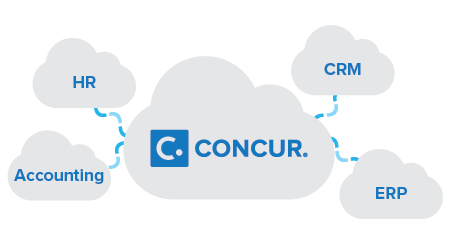SAP Concur Integration Introduction

Integration of SAP Concur with accounting and ERP system
The SAP Concur integration solution facilitates data synchronisation between your SAP Concur platform and another business system to automatically create journal entries or invoices in your ERP or accounting system when an expenses or payment reference workflow has completed in SAP Concur. This then enables workflows to be extended from SAP Concur into an ERP or Accounting system where the invoice payment process can be completed.
Based on our experience, here are some of the common scenarios that lead to SAP Concur integrations:
- Synchronize all financial data and other info automatically between SAP Concur and Other business systems.
- Synchronize the listing of the items and expenses e.g. for cost centres, profit centres, expenses to a specific project including support for multi-currency.
- Automation of general ledger entries and invoicing.
- Automated extraction of the expense data from SAP Concur.
- Automate scheduling of supplier payments.
- Automate SAP Concur expenses reporting and purchase orders.
- Business partner and employee synchronisation
- Complete visibility and traceability of your financial transactions in across the systems in real time.
Understand business and technical goals of the integration
To come up with an integration approach, our first task is to understand the business and technical goals we want to achieve.
To better understand the need for integration and the challenges involved , consider the following questions:
- Analyse the type of business problem or business requirement (e.g. is it a business process automation, a data synchronisation or a real-time communication requirement between two systems).
- What is the current process we’re looking to integrate? What are the pain points? How the process might change in future?
- What is the end state of this automated integration? Are we looking to roll out the integration in phases?
- What are the communication mechanisms or protocols to connect with systems in the scope? Draw a landscape of the systems involved, and discover the communication mechanism/protocols of each systems. These can be API, JDBC, JMS, TCP, FTP etc.
- What are the data objects involved with the integration? What is the access mechanism to these data objects ?
- Discover and analyse the data model of objects in all the systems, which should participate in the solution.
- Draw the data flow on the system landscape diagram. How should the integration be triggered — real-time, event-based, scheduled, or on-demand?
- What’s the size of the data in scope? Will we need to run the integration in batch mode?
- How do we want to be notified on the outcome of the integration, and what information should this notification include?
- How would this integration recover from exceptions — human intervention, auto-recovery, or a combination of both?
Answering these questions will help to understand business goals and design an integration framework that accelerates implementation and ease the ongoing support.
Concur Integration options
Concur support mainly 2 integration approaches : by delivering flat files and/or utilising web services (APIs) for integration. Based on the type of integration use cases, either real-time or batch, APIs or files based integration would be used.
Concur APIs:
SAP Concur APIs allow clients or partners to access data and functions within the SAP Concur product ecosystem. Through the use of these exposed endpoints and functions you can solve a vast array of different business issues and reporting needs such as:
- Pull data from SAP Concur for in-depth reporting services.
- Reconcile or validate your data by comparing SAP Concur data to what you have.
- Post new data into SAP Concur allowing for programmatic creation of information.
- Update existing information in SAP Concur to match your system data
Most iPaaS offerings ( Dell Boomi, Mulesoft, Informatica Cloud) provide pre-built Concur connector that are ready to use, which utilises Concur APIs in the background. These connectors are pre-packaged cloud-to-cloud connectors with easy-to-use and flexible mapping functionality.
- Support for custom attributes: Concur Rest APIs exposes custom attributes that can then be queried or updated by APIs directly.
- Support for multiple objects: Rest APIs support working on multiple objects in parallel or sequence, which would ensure data integrity and keeping the systems in sync.
- Performance Benefits: There are performance benefits of using APIs compared to any connectors that would be using APIs in the background.
- Working with latest version: working with APIs directly means you work with latest version and list of the APIs.
Concur SFTP ( For Flat-files):
Another out-of-the-box approach to Concur integration is utilising Concur SFTP, which can be used for both inbound and outbound flat -file integration. This approach is mainly used for bulk data imports as well as exports.
Electronic files are exchanged at Concur hosted FTP site, using PGP encrypted FTPS or SFTP. Concur SFTP works as either a source or a target within cloud integration and also interacts with other applications.
If you are exploring ways to integrate Concur with other business systems and would like some guidance, contact us or get in touch with us at [email protected] or in the chat window below.






